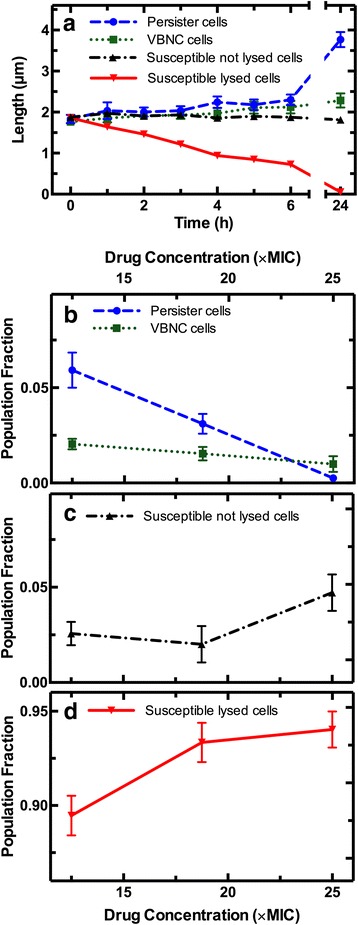Fig. 2.

Dimension and fraction of viable but non-culturable (VBNC) cells. a Average length of VBNC cells (green squares), alongside persister (blue circles), susceptible non-lysed (black upward triangles), and susceptible lysed cells (red downward triangles) before (t = 0), during (0 < t < 3 h), and after treatment (3 < t < 24 h) with ampicillin at a concentration of 25 × minimum inhibitory concentration in Lysogeny broth. We assigned a length value of zero to cells that became undetectable with our code upon cell lysis. This explains the decrease in the average length of susceptible lysed cells. Lengths of untreated cells in control experiments are reported in Additional file 1: Figure S1a. Bacterial width did not significantly change throughout the experiment for the different phenotypes but for susceptible lysed cells (data not shown). Data and error bars are mean and standard error of the mean obtained by averaging single-cell values (n SL = 1651, n P = 33, n VBNC = 48, n SNL = 87) measured in the microfluidic experiment illustrated in Fig. 1 performed on biological triplicates (N = 3). We did not observe any significant difference between the results obtained from different biological replica. Due to the large sample sizes, error bars are small compared to the corresponding mean values and are hidden behind some of the data points. Ampicillin concentration dependence of the fraction of (b) VBNC and persister cells surviving the antibiotic challenge, of (c) susceptible non-lysed cells, and of (d) susceptible lysed cells killed by the antibiotic challenge. Data and error bars are obtained by averaging each phenotype frequency measured at least in biological triplicate
